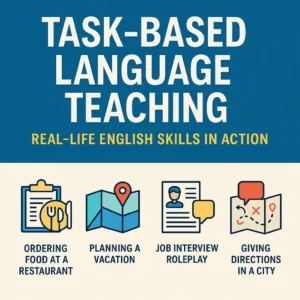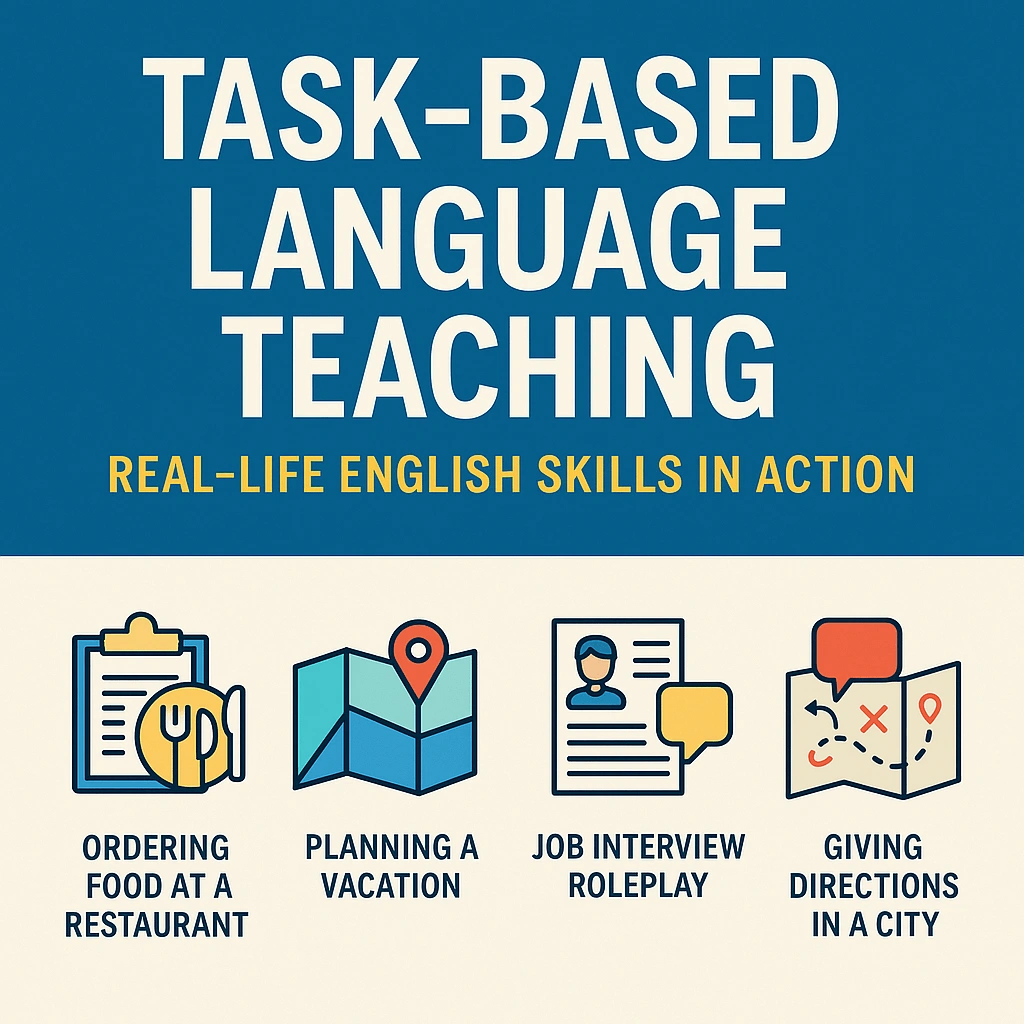Task Based Language Teaching (TBLT) is one of the most effective methods for teaching English as a second language today. It focuses on real-world communication instead of memorizing grammar rules. Students learn English by completing meaningful tasks—just like they would in everyday life. The principles of Task Based Language Teaching promote engagement and practical application.
In this blog, we will explore what TBLT is, why it works so well, and how teachers can apply it in classrooms. Whether you teach kids, teens, or adults, TBLT can make your ESL lessons more exciting and useful.
What is Task-Based Language Teaching?
This section will emphasize the importance of Task Based Language Teaching in developing language skills through immersive experiences.
Task-Based Language Teaching is a method of teaching English that uses real-life tasks to help students learn. A “task” is any activity where students use English to complete a goal.
Understanding Task Based Language Teaching is crucial for effective teaching. By integrating TBLT, educators can enhance their students’ learning experiences.
Examples of tasks:
-
Booking a hotel room online
-
Ordering food at a restaurant
-
Writing an email to a friend
-
Solving a problem in a group discussion
-
Planning a trip and creating an itinerary
Instead of focusing on grammar first, TBLT focuses on communication and meaning. Grammar and vocabulary are learned through use—not through memorization.
Why TBLT Works So Well in ESL Teaching
Task Based Language Teaching also allows students to apply their knowledge in practical situations, which is essential for language retention.
Understanding the Benefits of Task Based Language Teaching
Task-Based Language Teaching works because it mirrors real life. Here are some major benefits:
Implementing Task Based Language Teaching can lead to improved communication skills among students, making them more adept at using English in real-life scenarios.
1. Builds Confidence
Students get to use English in a natural way. This builds speaking and listening confidence.
2. Encourages Teamwork
TBLT often includes pair or group work, which helps learners practice in social situations.
3. Focuses on Real Communication
Students are not just repeating after a teacher—they are making choices and expressing themselves.
4. Supports Different Learning Styles
Whether students learn better by speaking, writing, or doing, TBLT can include it all.
Task Based Language Teaching can cater to various learning preferences, ensuring all students have the opportunity to thrive.
5. Makes English Useful
Students see that learning English helps them do things in real life. This keeps them motivated.
Through Task Based Language Teaching, students can see the direct benefits of learning English, which boosts their motivation and dedication.
The 3 Stages of a Task-Based Lesson
A successful TBLT lesson has three basic parts:
The stages of Task Based Language Teaching are designed to facilitate effective learning and application of language skills.
1. Pre-Task
In this stage, you introduce the topic. Give students useful vocabulary or grammar that will help them during the task.
Example: If the task is planning a vacation, introduce travel words like “book,” “destination,” “budget,” and “itinerary.”
2. During Task
This is the main part of the lesson. Students complete the task using English. The teacher’s role is to observe and guide—not correct every mistake.
Example: Students work in pairs to plan a 3-day trip to Bangkok using travel websites and a given budget.
3. Post-Task
In this stage, students review what they did. They might present their work to the class or reflect in writing. You can also correct common mistakes gently and reinforce vocabulary.
Example: Groups present their trip plan. Then, the class votes on the best itinerary and discusses it.

Example Task-Based ESL Lessons
Utilizing Task Based Language Teaching in lessons can help students gain confidence in their abilities to communicate in English.
Here are some ideas you can use in your own ESL classroom:
Task: Ordering Food at a Restaurant
-
Pre-Task: Learn food vocabulary and practice polite phrases.
-
During Task: Roleplay in pairs—one student is the waiter, the other is the customer.
-
Post-Task: Students switch roles and give feedback to each other.
Task: Planning a Vacation
-
Pre-Task: Learn travel words and read a sample itinerary.
-
During Task: Work in teams to plan a 3-day trip using real websites.
-
Post-Task: Present your plan and explain your choices.
Task: Job Interview Roleplay
-
Pre-Task: Learn common interview questions and answers.
-
During Task: Practice in pairs—one is the interviewer, the other the candidate.
-
Post-Task: Group feedback and discuss better answers.
Task: Giving Directions in a City
-
Pre-Task: Review place names and direction phrases (left, right, block, etc.).
-
During Task: One student asks for help; the other gives directions using a city map.
-
Post-Task: Change roles and review new words.
Tips for Using TBLT in the Classroom
The effectiveness of Task Based Language Teaching lies in its ability to engage students and make learning relevant.
Here’s how to make your task-based ESL lessons more effective:
Use Clear Instructions
Explain the task step by step. Make sure students know the goal.
Keep Tasks Realistic
Use tasks that are close to what students will face in real life or online.
Don’t Over-Correct
Let students speak freely during the task. Correct only after the task is finished.
Use Technology
Apps like Padlet or Kahoot can make tasks more interactive.
Mix Skill Levels
In group tasks, mix stronger and weaker students so they help each other.
Where Can You Learn More?
Exploring Task Based Language Teaching can provide educators with innovative strategies to enhance their teaching methods.
If you want to go deeper into TBLT or find ready-made lesson plans, check out these helpful websites:
-
🔗 British Council: Task-Based Learning
For those interested in Task Based Language Teaching, numerous resources are available to support lesson planning.
These platforms offer free and paid resources that can help you plan exciting ESL lessons.
Educators can find inspiration in Task Based Language Teaching to create interactive and engaging learning environments.
TBLT vs Traditional Grammar Lessons
| Feature | TBLT Approach | Traditional Grammar Lesson |
|---|---|---|
| Focus | Real-world communication | Grammar accuracy |
| Classroom activity type | Tasks and projects | Drills and exercises |
| Language use | Meaning-focused | Form-focused |
| Student engagement | High (interactive) | Often low |
| Feedback timing | After task | During practice |
Who Can Use TBLT?
TBLT is great for all age groups:
-
Young Learners – Use play-based tasks like shopping roleplays or storytelling.
-
Teenagers – Assign projects like planning a music festival or debating topics.
-
Adults – Try job interview practice, business presentations, or travel planning.
Even beginner-level students can do TBLT with simple tasks and support.
Final Thoughts
Ultimately, Task Based Language Teaching transforms language learning into a dynamic and rewarding experience.
Task-Based Language Teaching helps students build useful English skills through meaningful tasks. It encourages fluency, creativity, and confidence in a fun, real-world context. Embracing Task Based Language Teaching is essential for modern educators.
As an ESL teacher in Asia or anywhere in the world, adopting Task Based Language Teaching can make your lessons more powerful and engaging. Students won’t just “learn English”—they’ll use it in practical and real-world situations.


